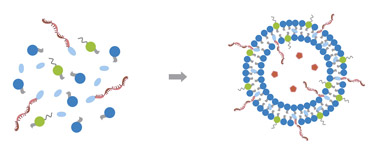Local Mechanical Properties of White Matter Structures in the Human Brain
Curtis L. Johnson
The noninvasive measurement of the mechanical properties of brain tissue using magnetic resonance elastography (MRE) has emerged as a promising method for investigating neurological disorders. To date, studies have been limited to global alterations in mechanical properties, though quantification of the stiffness of specific structures in the white matter architecture may be valuable in assessing the localized effects of disease. Localized property measurements have been limited in the past due to lack of spatial resolution, and we recently introduced a method for acquiring high-resolution brain MRE data. Here we report the mechanical properties of the corpus callosum and corona radiata measured in healthy volunteers using high-resolution MRE and atlas-based segmentation. Both structures were found to be significantly stiffer than overall white matter, and the corpus callosum exhibited greater stiffness and less viscous damping than the corona radiata. Reliability of both local and global measures was assessed through repeated experiments, and each measure exhibited excellent repeatability. Mechanical properties within the corpus callosum demonstrated high correlations with measures of underlying microstructure from diffusion tensor imaging.
Identifying neuropeptides induced by exposure to a cocaine-associated context and exercise in mice
Martina Mustroph
I recently showed that wheel running can facilitate extinction of conditioned place preference (CPP) for cocaine if running occurs after conditioning. However, mechanisms underlying CPP extinction from running are unknown. Given that the hippocampus and amygdala play an important role in contextual conditioning, it is reasonable to hypothesize that neuroadaptations from running in these regions underlie the rapid extinction of CPP. In my current research, I am determining whether the accelerated extinction of cocaine CPP is associated with altered expression of neuropeptides in hippocampus and amygdala of C57BL/6J mice. I am using state-of-the-art neuropeptidomic technology in collaboration with the Sweedler group, one of the world’s leading peptidomics laboratories. The proposed research is innovative because it uses a peptidomics approach to identify known and novel neuropeptides that interact with running and cocaine reward. Once these neuropeptides are identified, developing effective treatments to help maintain abstinence from drug addiction may become possible.
Enhanced Breast Cancer Therapy with DNA Aptamer-Functionalized Liposomes
Hang Xing
Selective targeting of cancer cells is a critical step in cancer diagnosis and therapy. Among the available classes of ligands used for selectivity, DNA aptamers have attracted significant attention. However, while their use in targeting cancer cells in vitro has been reported, their effectiveness has rarely been established in vivo. Here we report the development of a liposomal drug delivery system for future use in targeted chemotherapy. Liposomes were synthesized containing the anticancer drug doxorubicin (Dox) as a payload, and functionalized with AS1411, a DNA aptamer with strong binding affinity for nucleolin (NCL). As nucleolin is overexpressed on the surface of many cancer lines, the vehicle specifically recognizes cancer cells and enables drug delivery with enhanced specificity and selectivity for cancer cells. Specific cellular internalization of the NCL aptamer-functionalized liposomes to MCF-7 breast cancer cells was demonstrated in vitro. Dox-containing aptamer-functionalized liposomes (Apt-Dox-Lip) showed enhanced cytotoxicity to MCF-7 cells as compared to liposomes functionalized with a non-aptameric DNA sequence. Furthermore, Dox-containing aptamer-functionalized liposomes showed enhanced antitumor effects in athymic nude mice bearing xenograft MCF-7 tumors, attributable to their enhanced tumor tissue penetration. These results indicate that aptamer-functionalized liposomes are a promising targeted drug delivery system for future clinical cancer therapy.

